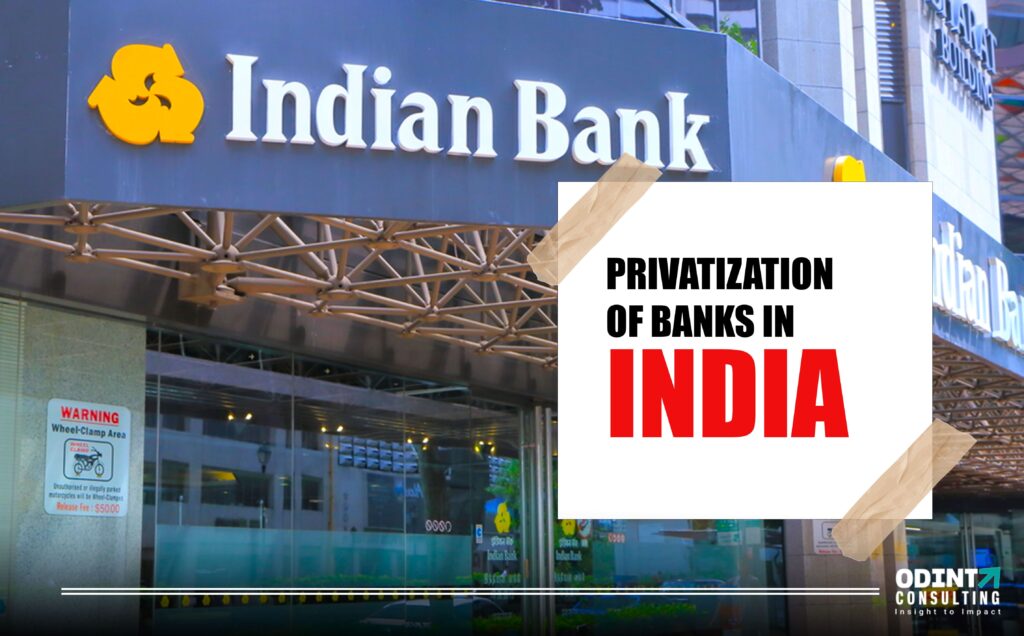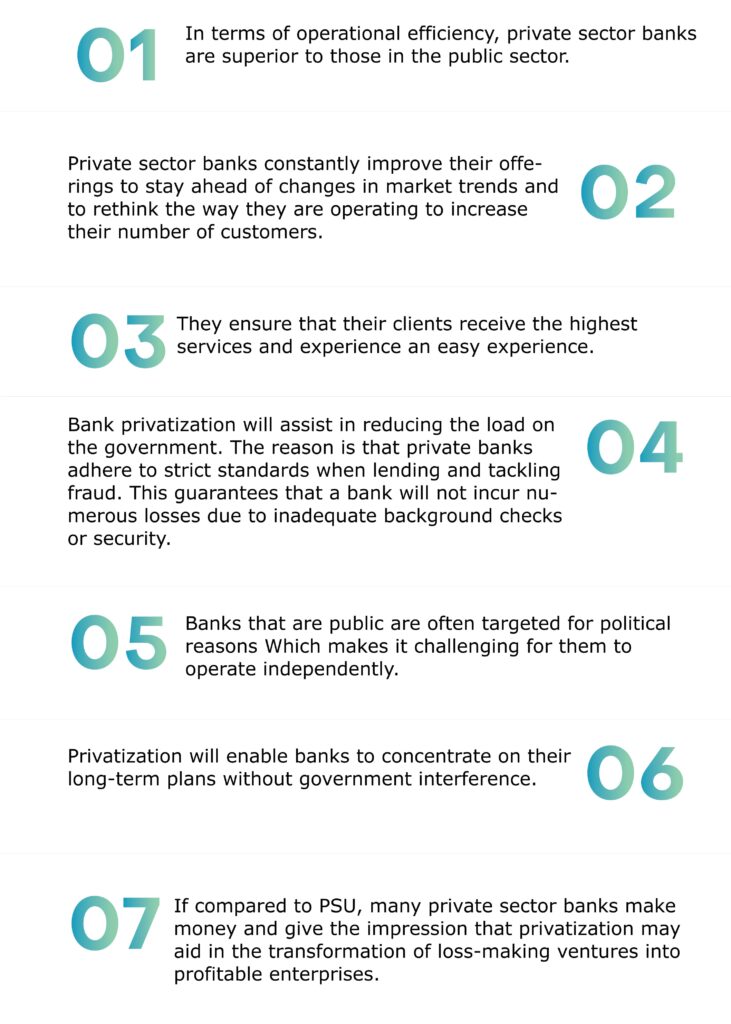
Privatization Of Banks In India 2022
The government has made some changes to the Banking Laws (Amendment) Bill 2021, which will privatize two public sector banks. The banks that NITI Aayog recommends privatizing are expected to generate 1.75 lakh crore of capital into the exchequer of the government.
The privatization of banks in India will lower the government’s stake from currently 51% to just 26 percent. The government has plans of introducing the Bill during the winter session.
For the privatization of two banks in the public sector, modifications must be included within the Banking Companies (Acquisition and Transfer of Undertakings) Acts of 1970 and 1980, and the Banking Regulation Bill, 1949.
Read More: Indian Company Registration Process
Nationalization of Banks in 1969
In 1969, the government of India 1969 started 1969 the nationalization process for commercial banks.
This was done in mind the financial condition of the was in the midst of a crisis, and also the real and urgent demands to invest the nation’s capital into priority sectors like agricultural development and the establishment and development of the industrial heavy industry.
The country also required investments in other areas like large companies, small business exports, and other sectors. In 1969, the decision to the nationalization of the commercial bank was required due to the situation of the economy with a shortage of capital that could invest in most important sectors.
But, the needs of today for privatization of banks owned by the public differ. The government requires to create strong banks with greater lending capacity as well as the capacity to absorb losses and cover losses through NPAs.
The government believes the introduction to the market by private companies will provide the benefits of greater efficiency of operations and opportunities to incorporate new technologies into the banking industry that the government is unable to pursue.
What exactly is "Privatization"?
Privatization is a procedure where the government loses control of the management and ownership of the state-owned company and transfers it to a privately-owned company in India.
The decision is made by the government assuming that privatization can bring more efficiency, and also turn the loss-making government agency into a profitable business. The first time privatization was implemented was following the historic budget of 1991 which was the first time to introduce the liberalization policy as well as globalization, privatization.
The basic services provided by the institution remain identical regardless of the type of bank, customers can are able to notice a major difference in the way they operate between the public sector bank & one that is a private sector.
The private sector banks certainly perform better in comparison to public sector banks, however, due to their long period of existence they have earned popularity with the general people and are generally more popular than private sector banking.
But with the evolving trends, business owners are also choosing private sector banks due to their effectiveness. In the current scenario, the idea of privatizing banks has been met with some mixed responses.
What is "strategic disinvestment"?
Strategic disinvestment is the method of selling the stake of an undertaking of the public sector to a private business by liquidating its assets, & passing control over the management of the company to those in private.
The control typically is transferred to up to 50% of the business or as much percentage that the relevant authority permits.
The necessity for strategic disinvestment comes when the government needs to relieve itself of the financial burden of the venture or to raise capital for investment to meet a particular purpose.
Legislative framework to allow the bank privatization
The bill that was recently introduced Banking Laws (Amendment) Bill 2021 is aimed at introducing needed amendments to the Banking Regulation Act, 1949 to allow the privatization of two banking institutions could be started as the government had proposed as part of the Union Budget of 2021.
The government is planning to amend the Bank Companies (Acquisition and Transfer of undertakings) Acts of 1970 and 1980 in order to implement the said privatization plan.
Another law in the statute book that plays an important part in the privatization of the banking institution would be the Banking Regulation Act, 1949, which is accountable for regulating banks and other companies that are involved in the business.
It also empowers and enables RBI to oversee the controls moratoriums, the mergers between banks, and liquidation.
Need for Privatization of Banks
The issue that is now being asked is the necessity of privatization of the banks owned by the government. While the privatization process for Banks is complex and time-consuming, the government wants to pursue such a plan due to the following motives:
Rising Non-Performing Assets (NPAs) by the Banks
One of the primary reasons, in addition to many others that prompted the government to move forward in privatizing the banks, is the growing number of NPAs, followed by a decrease in profit, market capitalization, and a poor performance record.
In order to free its assets from stress, the government wants to liquidate its assets in the firm, believing that the introduction of private sector companies will bring efficiency and enhance the bank.
Recommendations from various committees
The government set up several committees with the goal of making changes in the sector of banking. Some of the committees which were established in the name of the Government have offered recommendations to cut the percentage of the government’s stake in public banks to less than 51 percent.
- The Narasimhan Committee recommended a 33 per percent stake for the government in the banks of the public sector.
- The PJ Nayak Committee recommended government stakes be below 50.
- Recently, an internal working committee of RBI has suggested the conversion of some NBFC’s to banks.
The growth in lending capacity and the formation of Big Banks
The aim of the government is to create large banks by combining the public sector banks and the private banks that exist, so that they grow in scale and size, and also enhance their loan capacity. This will in turn boost the risk-taking capacity of these banks.
The banks with a larger lending capacity can invest in high-value development projects and invest in national-level projects.
Vision for Future of banks
Banks will be privatized. This is in line with the long-term vision of the government, which is to have only a small number of banks in the public sector, and the remaining banks are either privatized or merged with private banks already in existence. This reduces the tax burden for the government since it has to provide the banks with liquidity to pay for losses.
The creation of strong banks
Another goal of privatization was to establish strong banks and decrease the strength of banks that are public through privatization and merging them with private banks.
A bank with a strong balance sheet and large pockets is more likely of absorbing NPAs and managing risk. The odds of a solid bank going into bankruptcy are less and the failure of a few projects won’t affect the existence of the bank due to the massive magnitude of its bank.
Benefits of Privatization Of Public Sector Banks

- In terms of operational efficiency, private sector banks are superior to those in the public sector.
- Private sector banks constantly improve their offerings to stay ahead of changes in market trends and to rethink the way they are operating to increase their number of customers.
- They ensure that their clients receive the highest services and experience an easy experience.
- Bank privatization will assist in reducing the load on the government. The reason is that private banks adhere to strict standards when lending and tackling fraud. This guarantees that a bank will not incur numerous losses due to inadequate background checks or security.
- Banks that are public are often targeted for political reasons Which makes it challenging for them to operate independently.
- Privatization will enable banks to concentrate on their long-term plans without government interference.
- If compared to PSU, many private sector banks make money and give the impression that privatization may aid in the transformation of loss-making ventures into profitable enterprises.
Concerns regarding the privatization of Banks
Here are a few of the issues relating to the privatization of banks
Concerns about capitalism based on cronyism by privatizing banks: When these public banks are privatized, these banks are likely to be auctioned to private companies that have already fallen behind in the payments on loans. This could worsen the situation and increase the amount of NPAs from these banks.
The financial exclusions of poorer segments of the community: An important function of public sector banking institutions is to provide the benefits of banking to the most deprived individual in society. Privatization of these banks means that they will focus on the wealthy and wealthy segments of society and not bother with those who are less wealthy.
Fear of job loss among the current employees of the public banks, as if the banks of the public sector are privatized or combined with other private ones, they will not have to duplicate their workforce and will begin to reduce their staff strength.
Although these issues may appear like small issues, the experiences in the private sector provide proof that a stressed and unhappy staff could ruin the whole company. Recently there have been a lot of major NPAs and loan default cases have been brought to light.
This is a reflection of how difficult it was for the RBI to stop this threat in the days when banks of the public sector were under strict oversight by the RBI. But, if these banks are separated from the control of the RBI There is a greater chance of being in default.
Conclusion
The main reason behind the privatization of Public Sector banks is to provide the needed improvement in the management and governance of public banks, as well as to relieve the government of the loss they incur because of the rising NPAs.
In the alternative, the government must make their corporations that will be able to grant the autonomy to banks in their activities without requiring the government to give up ownership control of the banks.
If you have any more queries related to the privatization of banks in India, we are ODINT Consultancy, here to help you out in each & every step of yours.
FAQ’s
This can easily be checked by seeing if the NIP or REGON are associated with the company in question. In the case of a sole proprietorship, they don’t own a KRS number so the NIP or REGON needs to be checked.
Share capital amount around PLN 50,000 is necessary to form a company, and it is also crucial to have NIP or REGON also including the register of VAT payment.
CEIDG is a business book of entries with info on self-employed entrepreneurs. Any sole trader must register in CEIDG.
